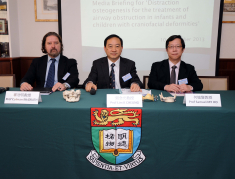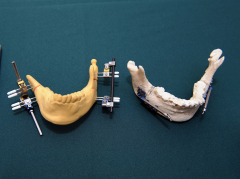Media
Research team led by HKU Faculty of Dentistry wins major funding to surgically treat airway obstruction in children who have craniofacial deformities
10 Dec 2013
A research team led by the Faculty of Dentistry of the University of Hong Kong (HKU) has been awarded a grant of HK$4.26 million by the S.K. Yee Medical Foundation to perform a special type of bone surgery in infants and children to treat upper-airway obstruction caused by skull or facial deformities. Key members of the team held a media briefing about the research project today (10 December 2013).
The research funding will allow the team to perform a biomedical engineering procedure, known as distraction osteogenesis, to treat airway obstruction by correcting the underlying physical jaw and skull deformity. First, a surgical cut is made across the bone causing the deformity to create a gap. Then the bone segments are attached to an appliance, called a distractor, which contains a special screw. Turning the screw for one rotation each day gradually lengthens the bone.
The team’s leader, Professor Cheung Lim-kwong, Chair Professor of Oral and Maxillofacial Surgery at the HKU Faculty of Dentistry, explained that distraction osteogenesis stimulates the generation of new bone between the separated bone segments. The method therefore avoids the need for a bone graft transplant, which has a long operative time because of graft harvesting.
The awarded grant will support the cost of various distractor systems needed to treat 36 children and infants with upper-airway obstruction because of craniofacial deformities, who come from financially challenged families in Hong Kong. The patients will be recruited from the Queen Mary Hospital, United Christian Hospital and Prince Philip Dental Hospital.
Professor Cheung said that if untreated, partial or complete upper-airway obstruction can lead to difficulty in breathing (respiratory distress) or interrupted breathing during sleep (obstructive sleep apnoea). His multidisciplinary team will assess the effectiveness of distraction osteogenesis in treating moderate to severe obstructive sleep apnoea, as well as the impact on the patients’ psychological well-being and quality of life.
“The project findings would have great importance for the scientific literature and for parents’ and medical professionals’ information in the treatment of airway obstruction in Chinese children and infants”, he said. “The findings would also be of value to the Hong Kong government in defining the strategy of helping children suffering from obstructive sleep apnoea, and improve public understanding of obstructive sleep apnoea and the treatments that can cure this debilitating condition”.
Professor Cheung commented that his team expected positive results, referring to a review study in Plastic and Reconstructive Surgery that he co-authored in 2008. That review of all relevant studies published from 1966 to 2006 found that distraction osteogenesis of the lower jaw was effective in treating upper-airway obstruction in 97% of 67 children with respiratory distress orobstructive sleep apnoea. The procedure also prevented the need for an airway operation to help with breathing (tracheostomy) in 91.3% of 92 newborns or infants.
Obstructive sleep apnoea has negative impacts on a child’s neurocognitive development, schooling and learning, social adjustment, emotional regulation and family relationship, said team member Professor Samuel MY Ho, Honorary Professor of Oral and Maxillofacial Surgery at the HKU Faculty of Dentistry and Associate Head of the Department of the Applied Social Studies, City University of Hong Kong. “Positive psychological effects have been reported for patients treated by distraction osteogenesis. In particular, early diagnosis and treatment of obstructive sleep apnoea prevent subtle but potentially irreversible brain damage,” he added.
Another team member, Professor Colman McGrath, Clinical Professor in Dental Public Health at the HKU Faculty of Dentistry, said distraction osteogenesis of the lower jaw to treat upper-airway obstruction improves quality of life, according to a study of 21 children that was published by a team in North America in the International Journal of Pediatric Otorhinolaryngology 2012. He said: “the 3-year HKU-led study aims to allow children to develop and have a normal life and enhance their quality of life”.
Other team members of this project are Dr John Lo (Clinical Assistant Professor in Oral and Maxillofacial Surgery) and Dr Ivan WK Tsui (PhD student) from the HKU Faculty of Dentistry, and Dr Siu-chung Fung, Chief of Service, Department of Dentistry and Maxillofacial Surgery, United Christian Hospital.
Sources:
Ow, ATC, Cheung LK. Meta-analysis of mandibular distraction osteogenesis: clinical applications and functional outcomes. Plastic and Reconstructive Surgery 2008; 121: 54e-69e.
Medline link to research article: http://www.ncbi.nlm.nih.gov/pubmed/18317087
Hong P, McNeil M, Kearns DB, Magit AE. Mandibular distraction osteogenesis in children with Pierre Robin sequence: impact on health-related quality of life. International Journal of Pediatric Otorhinolaryngology 2012; 76:1159-1163.
Medline link to research article: http://www.ncbi.nlm.nih.gov/pubmed/22591983
Media contact:
Mr Oi-sing Au, Communications and Development Officer, Knowledge Exchange Unit, Faculty of Dentistry, The University of Hong Kong, Tel: 2859 0454; E-mail: singau@hku.hk
For more information about the HKU Faculty of Dentistry, please visit http://facdent.hku.hk;
Facebook page: www.facebook.com/facdent

From left to right : Professor Colman McGrath, Clinical Professor in Dental Public Health, HKU Faculty of Dentistry; Professor Cheung Lim-kwong (project leader), Chair Professor of Oral and Maxillofacial Surgery, HKU Faculty of Dentistry; and Professor Samuel MY Ho, Honorary Professor of Oral Maxillofacial Surgery at the HKU Faculty of Dentistry and Associate Head of the Department of Applied Social Studies, City University of Hong Kong.

